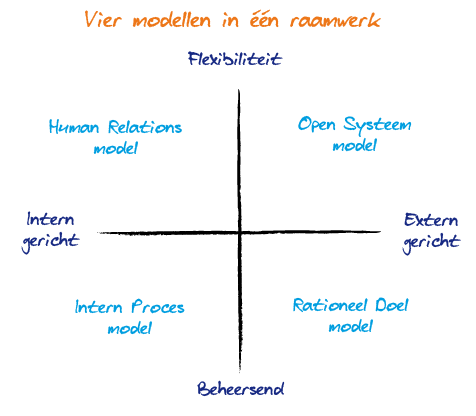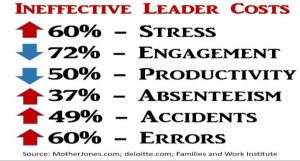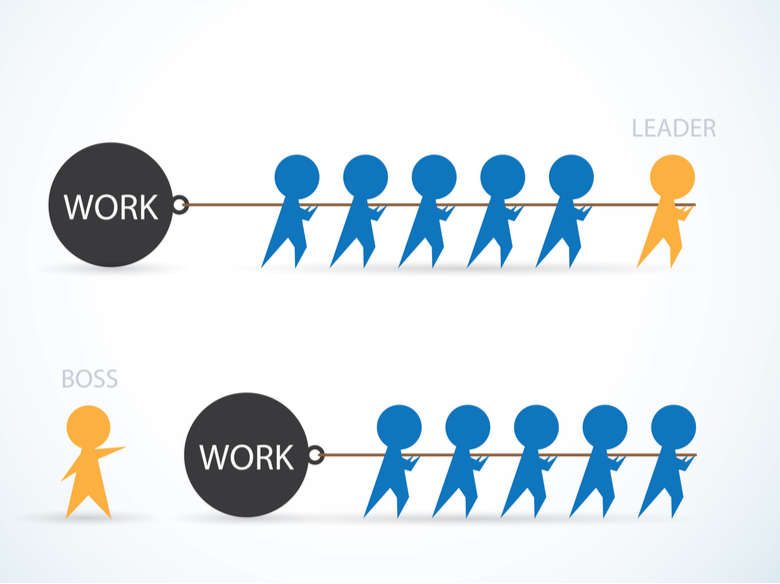Leadership is not a one-person job anymore its crucial for understanding organizing as it shapes groups and relationship and can be detected in practice. (Vuuren, 2018; Ganz, 2010)
Our previous blog: ‘recognize an effective strategy execution’ stated a possible balance in a complex digital environment. Now we focus on recognizing a successful leader. Without a successful leader there is no effective strategy execution and without an effective strategy execution there is a great change the organisation won’t survive the next 5 years (Pijl, 2018). Quinn can explain the quote of Ganz (2010) by emphasizing a strong correlation between an effective organisation and the way leaders are able to find balance in an adequate use of multiple frameworks that fits a context (Tiggelaar, 2012; Quinn, Faerman, Thompson, McGrath, & St. Clair, 2010).
The question Robert Quinn ask managers is: ‘How good are you in using managerial frameworks that’s fits the context?’.
And I learned from practice that it is good to ask this question with a deep look in the mirror. Am I organizing the right things? And am I organizing the things right? (Drucker, 2002)
A SUCCESFULL LEADER: AN ADAPTIVE INSTRUMENT
Quinn distillates four models and eight manager roles.
1. The rational purpose model
- Goal: achieve control and focused on the environment outside
- Needs a producer: engaged, task oriented, accomplish every goal.
- Needs a manager; give vision, plans, goals, giving instruction, organize and delegate, making expectations clear.
2. The intern process model
- Goal: control and focused on the environment inside
- Needs a coordinator: a good project manager, can create clear tasks, and has a good spin of control.
- Needs an inspector: good insight of what’s going on in the organisation, he inspect, analyse and paying attention to details.
3. The human relations model
- Goal: flexibility and focused on the environment inside
- Needs a stimulator: encourage the intrinsic motivation, stimulate cooperation, build a team, facilitate the voice of the employees, honest, does not think in positions but in optimal interests.
- Needs a mentor: focused on the development of the employees, he got knowledge of human nature, can communicate well, approachable. His aim is to bringing the best out of people.
4. Open system model
- Goal: flexibility and focused on the environment outside
- Needs an innovator: people with vision, who sees the need of the market and can translate it in solutions.
- Needs a mediator: focused on the relationship between the organisation and the market. Image, presentation, reputation are important.

The four frameworks give us an insight which form of leadership is needed in which context. When flexibility and external focus is needed in the organization, don’t use managers but use innovators give them the space to use their intrapreneurial talents! I like the frameworks of Quinn because it also facilitate the way how we bring focus, synergy and kind of leadership between the 5+1 powers described in chapter 2 organisation. For me it also emphasize the need to find balance in organizational changes. You need to invest in the right profile in the right place. But I am also aware of the weakness of applying these framework in practice because in reality the situation is far more complex then described. Because you work experienced people and inexperienced people. Very talented people on the right place and people who do not shine because they are not on the right place. That makes us come to situational leadership (Blanchard, 2006). In short, leadership style depends on the intrinsic motivation and competence of the employee or organisation. Is the intrinsic motivation and competence low it need to be directed. Is the intrinsic motivation and competence high it need to delegated.

I don’t want to explain the situational leadership in dept because I expect that my readers have a deep insight and experience in leadership. But I want to describe it to emphasize leadership is situational and need to be divided to create a constructive social and situational reality. One person can’t be a sheep with five legs! I like this situational model because its challenge us in two ways:



The work of Quinn and Blanchard shows us the importance of adequate behaviour of a leader, it correlate directly with the way of executing the strategy, financial success or failure and a constructive narrative organisation (Pijl, 2018). So if we think about recognizing a successful leader it is important to emphasize that you start with the right person on the right place! There is too much at stake!
SUCCESS FACTOR 4: MAKE WHO MORE IMPORTANT THEN WHY, HOW AND WHAT!
The most important success factor is the right person on the right place (Collins, 2001). Not how he talks about his work but how he act in his work. We all know this is true. How long do we see that loyalty sometimes overdue the fact that someone is not fit on the right place? You can be chosen as president of the United States of America but that doesn’t mean people will follow you! Remember the (narrative) organogram? The real divided power is not in the formal organogram but in the narrative environment! If there is no constructive narrative organogram there is no effective leadership and vice versa. And if there is no effective successful leadership there is a good change you toxic the organisation and thereby the quality of service (Pijl, 2018).
Managing by authority & Leadership by power
DeRue, D. S., & Ashford, S. J. (2010) propose leadership is co constructed by a claiming-granting process about leadership and followership.

I like the picture above because it’s not only an abstract way of how leadership and followership will be created but it is also a model that is applicable in practice. The formal organogram gives a boundary or authority between Person A and Person B but it’s to person B to accept this claim of leadership. If you want to continue your job I advise you to grand the formal leadership by mind. But that doesn’t mean a formal leader also have power. Power is granted by a leader-follower relationship by heart.
So my questions are: ‘Who can be the most successful and effective leader? The person with authority or the person with power?’

Do we understand that our employee is our most important customer? Do we understand that if we they don’t grant power there is no effective organisation! There is no effective leadership you’re at tops a talented manager leading a controlled sinking ship!
You remember the chapter: ‘recognize the new wine’? A good chance a talented manager with only authority works transactional, making goals and communication lines effective. But is not influencing the deeper parts, he is not constitutes a constructively organizational life of opportunities. A good leader makes good strategies, creates satisfied customers and is transformational (Peters T. , 2010; Kemperman, Geelhoed, & op ‘t Hoog, 2016). And if you feel you are not granted power by your claim of leadership something is going on! I believe power is granted by a personality that’s find synergy with the other person. To create synergy between person A and person B emotional intelligence is needed (Pijl, 2018). Pijl (2018) gives us a deep insight in practice. He suggest that in the top management there is a lot of hardworking talent but what makes them different in excellence? It’s their emotional intelligence, the wisdom of self-reflection, empathy, the ability to connect people whether you like them or not and observant exceptional well (Pijl, 2018). And I think its connected with servant leadership, who facilitate a sense of community, motivate the best in others. And I think it’s what Collins means with the level 5 leadership, a focus on the long term success combined with modesty and determination (Collins, 2001).
To make it more practical ‘employability’ is an important keyword. It is the responsibility of all parties to develop. If an organisation and employee does not offer enough to each other, it is necessary to talk normally and timely about it. If needed fire people, decisive and thoughtfully. Because every ex-employee is also an ambassador.
Followership: Involvement is the fuel to higher profitability
Involved employees contribute greatly by achieving strategical goals, profitability, maintaining talents, absenteeism, productivity and employee satisfaction (Pijl, 2018). The question is: ‘How do we create more engagement and involvement in our organisation?’ Pijl (2018) gives some tips:
- Be attractive: in our products, leadership, employees, daily work. If they are attractive, our organisation will be attractive. Deliver an inspirational vision! Explain to the Backoffice and teams why our work is so important and why some initiatives are necessary tell them the real WHY (Rimm, 2018). (see for practical information extra content)
- Good leadership is more servant then charismatic. Be authentic, be predictable, have a granting attitude, caring, challenge them. Be charitable and unrelenting; recruit strict, manage light and be personal!
- Involve the right people in new initiatives and give them responsibilities.
- Emphasize the positivity!
- Invest intensively in relationships!
- Invest in HR: recruiting, rewarding, organisational development but most important talent management. Ask HR to make 1 a4 with the most important names to keep in the organisation and a menu card with development actions.
- Judge and reward not only quantitative and financial. Money is the most expensive way to motivate people. But give opportunities to develop, personal attention, good coaching, feedback, respect, equality, inspiration and give compliments. Deliver goals and passion for the employee that serve the collective ambition because involvement is nothing without alignment.
I am not a great fan of bottom up thinking and people who say: ‘I give my teams all the space to fix things by themselves’. It’s a sign of not understanding how complex our environment is. I don’t say bottom up thinking is a destructive way of managing people on contrary, I think bottom up input need to be encouraged. But if we think about strategical changes it does not need to be honoured. A leader needs to give a clear strategical boundary, stick with it and explain it. And within, there is space for bottom up involvement. Pijl (2018) emphasize this by saying:
‘It’s wrong to think every involvement in the organisation is good!’
There something like destructive involvement and employee satisfaction tests are not a causal reason to think the employee are engaging in a constructive way of moving a way that’s benefits the collective goals (Graber, 2018).
Exemplary followership: ‘a constructive disruptive employee’.
Kelley (1998) suggest the following definition:
- Exemplary followership means begin actively engaged in helping the organization succeed while exercising independent, critical judgement of goals, task, potential problems, and methods.
- Exemplary followers have the ability to work cooperatively with a leader to accomplish the organization’s goals even when there are personality or workplace differences. They are key players in both planning courses of action and implementing them in the field.
- This definition contrast with what the average person thinks followership is: a work behaviour that shows managers and co-workers that ‘I know how to toe the line and not threaten the leader, take orders without question, and stick to the boundaries of my job description.’
It’s important to reflect as leader what are my internal belief systems (how must my colleague behave in relation to my function), are they moving to co creation and does it create synergy with my colleagues? It brings top-down management and bottom up management in perspective.
- What is my definition of exemplary followership and does it fit in the definition of Kelley?
- How can we create space for exemplary followership?
- What are the key elements of a successful leader?
- Which elements of leadership does our organisation need at this point?
- Are the right people on the right key position?
SUCCES FACTOR 5: MAKE STRATEGY EXECUTION YOUR NUMBER 1 PRIORITY!
Last year I was at a meeting. Old grey people mixed with some young people like me sitting in a circle on behalf of our organisations. Then a manager of the government ask us: ‘We got a big problem, how do we help people who doesn’t fit in regular health care?’ The conversation went in an early stage to the most beautiful analyses, all where nodding. Then a young lady said something I never forget: ‘You guys can talk with your fancy abstract words but where is the client in your story, where is the action and the willingness to do something about it?’ It stunned me and made me realize that at the end it all goes about executing your strategy: ‘do, do, do! You won’t achieve goals with only good strategical goals on paper!
According to Pijl (2018) every member of the top management needs to master ‘operational intensity’, it needs to define his profile. Operational intensity stands for effective and efficient involvement in all levels of the organisation so needed change can be executed well.
Rockwell (2014) says successful strategical leaders always emphasize what is absolutely necessary, bringing focus and simplicity. They formulate strategical goals clear and simple often in three to five points. Successful leaders are masters in bringing systematically focus and saying NO.
Pijl (2018) suggest that modern leaders has 12 absolutely necessary competencies:
- Strategical and analytical strong. In analysing the market, the organisation and in deciding which direction the organisation must go.
- Knows to translate the how, what, why and can create a sense of excitement and a sense of urgency.
- Has an entrepreneurship mentality.
- Works systematically to strength the execution, ownership and realising of goals.
- Simplify, create and force decisions, can think multidisciplinary.
- Believes in the intellect of the collective and objectivity decision making.
- Build trust in the organisation by openness, integrity and constantly connecting.
- Has power granted by employee. Is a craftsman!
- Constantly developing himself, if the leaders doesn’t develop them self, great chance the organisation don’t develop. Has a hunger for feedback!
- Is curious has more questions than answers.
- Does not praise bottom up thinking and has an eye for details.
- Choose for 20% strategy and 80% execution. It’s a natural reflex to think conceptual but to create value for the customer execution is needed.
